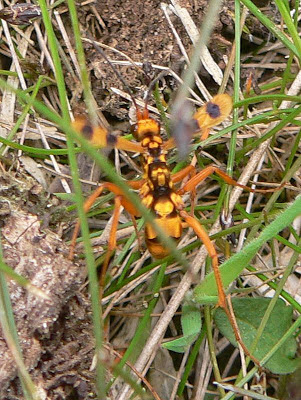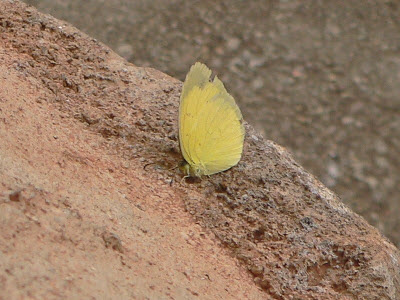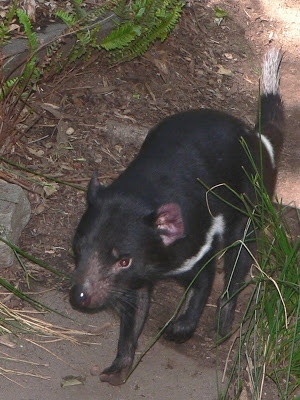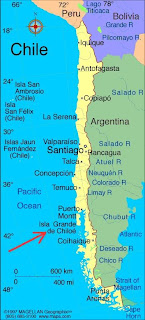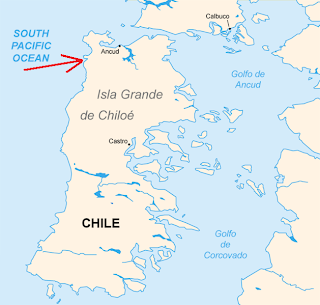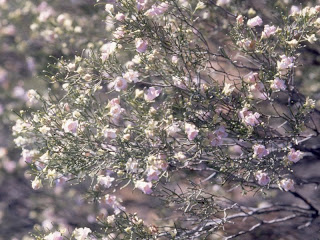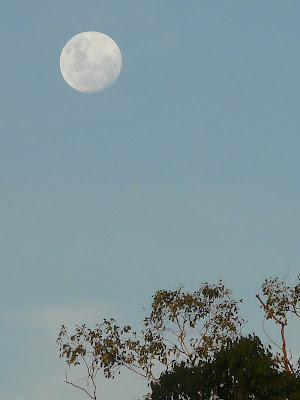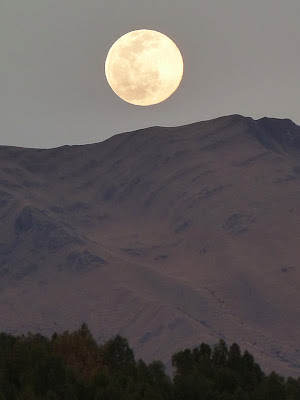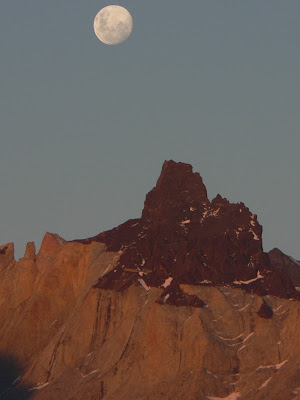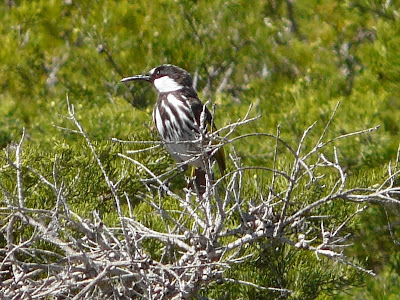Really there's only one natural history topic in Australia this week; the presentation of the first photos ever taken of a living Night Parrot at a remarkable extravaganza in a meeting room at the Queensland Museum.
I have hesitated long and angstfully before committing myself to this posting - so much has already been said that it's doubtful there's more that is useful to be written, and the whole issue is fraught with cross currents. On the other hand I've been challenged at home, quite justifiably, to explain my apparent curmudgeonliness about the whole issue (curmudgeon?! me?! never - grumph...). And in truth when I tried to, I found myself uncertain. So, here goes.
OK, some background. The Night Parrot Pezoporus occidentalis has almost mythical status, having probably only been seen by a handful of living people. As you would expect, it is essentially nocturnal, and its habitat is essentially Spinifex (or Porcupine Grass) Triodia spp. hummock grassland; in South Australia at least its favoured sites seemed to be stony rises. So far so good - until you realise that 25% of the whole of Australia (ie almost two million square kilometres) is dominated by spinifex...
![]() |
| Spinifex-covered hill, Gawler Ranges. Maybe there's a Night Parrot behind one of the clumps... |
It was described by John Gould in 1861, from a specimen from "the interior" of Western Australia. Subsequently he was delighted to discover that Ferdinand Mueller had obtained a live one from the Gawler Ranges in South Australia, and had sent it to the London Zoo, where Gould examined it. For much of its shadowy history, the Gawler Ranges were a hotspot for the parrot. Indeed, at one stage I knew of 17 skins, of which 12 were from South Australia and 10 from the Gawlers; I understand that the latest count of museum specimens is 24. Local accounts described it as abundant, but this might simply have reflected a time when shepherds were on the ground to see birds flushed by the sheep. From the 1880s fencing was introduced, which led to the demise of the shepherd and of Night Parrot reports. It may well be that increasing Dingo numbers (without shepherds to control them) were affecting the parrots, but it is impossible to be sure if the issue was less parrots or less observers.
![]() |
Night Parrots from John Gould's Birds of Australia.
courtesy National Library of Australia. |
Certainly, as the 20th century progressed, reports slowed to a trickle. The excellent South Australian Museum ornithologist Shane Parker saw a group of Night Parrots in northern South Australia in 1979, by searching on camels which enabled him to sight them well ahead. Other accepted sightings (six of them) cover a huge arc of Australia from the Pilbara in the far west to central Queensland; these include two dead specimens (a road kill, and a bird which flew into a barbed wire fence) in Queensland. So, there was no question that they are out there, but how to find a scarce bird which is reported to spend its days in tunnels under spinifex, sealed with bitten-off stems?
![]() |
Shaded area represents historical Night Parrot range; recent sightings as red dots.
Gawler Ranges at end of blue arrow.
Courtesy Wikipedia Commons. |
Enter controversial bird guide and entrepreneur John Young, and the whole story becomes a little surreal. I have not tossed off 'controversial' lightly. In the 1970s he sensationally declared that he'd found a breeding population of Paradise Parrots in north Queensland, well outside the known range - or I should say 'former range', because there have been no confirmed sightings since 1922 and it is officially extinct. No-one else ever saw the birds (though he showed a select group of three the purported nest, a hollow in a termite mound). Startlingly he claimed (confessed?) to have taken six clutches, a total of 31 eggs for unspecified purposes, though they have never turned up in any museum collections. He seemed to have lost interest in the birds, as there was no apparent follow up. The eggs, if genuine, would have commanded vast amounts of money in the black market; in this case I can only hope he was lying.
In 2006 came another dramatic claim - a new species or sub-species of Fig-Parrot from the rainforested ranges of the south-east Queensland-New South Wales border, with photographic evidence. Given that it was within the range of sub-species Coxen's Fig-Parrot, it could hardly have been another sub-species, so another species was implied (there is only one recognised). Where Coxen's has a red brow, this bird had a blue one. In addition to the photographs, Young claimed to have taken pin-feathers from chicks for DNA analysis. Everyone, including the Queensland government, was very excited. In the event the photos were examined by a scientific photographic expert at the Royal Melbourne Institute of Technology University, who declared that the areas of image containing the very features which made the bird in the image unique were, to use a technical term, dodgy. Remarkably, Young claimed to have deleted the originals! And the promised pin feathers apparently went the same way, because they never appeared.
So, when Young bobbed up again, inviting people to a presentation at the Queensland Museum (in a hired room) at which he promised to show photographs and video of Night Parrots somewhere in western Queensland, there was some disquiet. In the event only six seconds of the video were offered, but the photos were apparently incontrovertible this time. (I wasn't there, but I know people who were.) Some of Australia's most eminent bird people, who would certainly known of Young's form, were convinced, which is good enough for me. It seems that fears based on the boy who cried wolf (dingo?) were this time unfounded.
Quite properly he is not divulging the location. More disturbingly there are signs that he doesn't intend to let any professional scientists or wildlife managers in on the secret either. Since the previous incidents, relations between him and government people have been somewhat frosty. Indeed, he is talking about raising up to $3 million from the private sector to prepare a management plan. Whatever Young may be he is not a scientist, and to my knowledge has never written a management plan; on the other hand there are scientists already employed to do just that, with extensive experience and expertise.
Worryingly to me, one contact who was there reports that the 'white shoe brigade' was out in force. This is a reference to a group of Queensland Gold Coast property developers in the 1980s with powerful and wholly improper links to the state government. Is this where he's hoping the money will come from, and why he declined to show the video? It could worth quite a bit if offered as an exclusive. But of course I could be misreading the situation entirely and my contact may have simply misidentified a group of birders wearing suits and tennis shoes.
So why my slightly underwhelmed reaction, which surprised even me? Part of it is that I'm not taken by surprise, in that I've long taken an interest in the parrot, and have never doubted it's out there - the regular, though sparse, records make that impossible. So hyperbole comparing the very existence of it as being equivalent to finding a Thylacine or Elvis (it's true, someone did!) is a bit silly. Nor do I accept that there are only a very few hundred - or less - birds left, based on the few records. Those records span a couple of thousand kilometres of remote harsh country, and I've discussed the bird's very uncooperative behaviour. Of course we must adopt the precautionary principle and assume it is very rare, but I'd not be surprised if the opposite were found to be true; if the bird is living right across that range that means a large and well-buffered population.
I'm also very nervous about the way it's being kept from the people of Australia - not the location, that's essential, but everything else. The photos are made exclusive to The Australian, a notoriously right-wing News Limited paper whose only contribution to conservation in the past has been to attack it. The only access to the photos for the rest of us (via News Limited) is via a hefty fee 'with conditions'. This bird is no-one's private property, no matter how much effort and skill went to locating it. And there, I think, is the nub of my problem; the story ought to be all about the parrot, but it's somehow been shoved aside into a support role.
Nonetheless, just about everyone in Australia has now heard of it, which can only be good. We all await to see how the drama will play out; my big hope is that other populations are confirmed soon, preferably in a national park and by someone else. But what do you think?
BACK ON TUESDAY
+Pindar+0908.jpg)
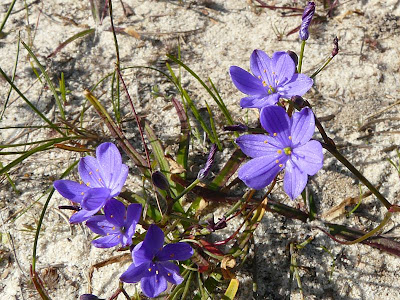+close-up+Lake+Monjimup+0908.jpg)
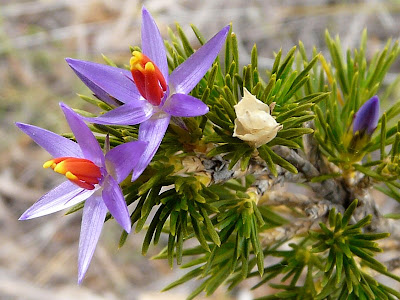+Moore+River+NP+0808.jpg)



+deformis+Alligator+Gorge+0807.jpg)









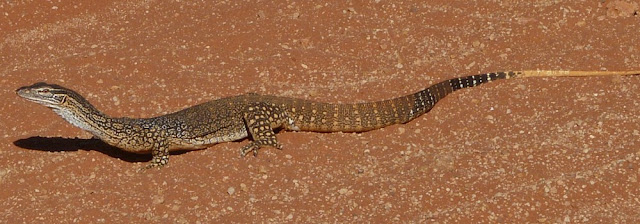


























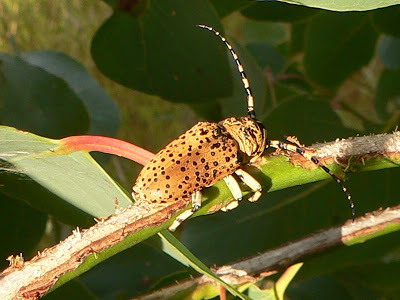+nr+Cooktown+0506.jpg)


